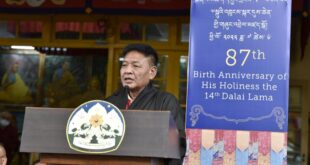By Robert D. Sloane
East Asia Forum | May 9th, 2012
In a recent article, Barry Sautman ascribes recent self-immolations in Tibet to a few disgruntled monks at a single monastery.

Their complaints, he says, reflect general social and economic issues rather than a genuine concern for the Tibetan people’s political and religious rights. Sautman borrows liberally from China’s tired propaganda book, which characterises all dissent from China’s occupation of Tibet and the massive human rights abuses against its people in the past half century as the work of terrorists or ‘splitists’. In this view, all dissent is instigated by the Dalai Lama and his ‘clique’, including suitably unidentified foreigners, who aim to restore a feudal theocracy in Tibet — never mind that the Dalai Lama has expressly relinquished his political authority to the fully democratic Tibetan government-in-exile.
The immediate impetus for Sautman’s editorial is that in the past three years 35 Tibetans have chosen to set themselves on fire to protest China’s continuing occupation of Tibet, demand freedom and human rights for Tibetans, and call for the return of the Dalai Lama to Tibet. Of the 19 incidents since January 2012, nine have taken place since the beginning of March. Most happened in historic Tibet, but in late March, Jampel Yeshi, a young Tibetan who fled Tibet in 2006 and lived in exile in India, died after self-immolating amid 600 demonstrators protesting President Hu Jintao’s visit to Delhi, bringing to four the known number of recent attempts at self-immolation by Tibetan exiles.
As for the nature of earlier self-immolation protests, it is true that a simple majority (about 60 per cent) of the incidents took place in and around the Kirti monastery, particularly in Aba (Tibetan: Ngaba), which is now part of the Chinese province of Sichuan. But it is false and misleading to suggest, as Sautman does, that the ‘vast majority’ took place there or, even more to the point, that this somehow shows that the acts do not reflect the sentiment of Tibetans throughout the ‘Tibetan Plateau’. In fact, Tibetan self-immolations have taken place not only in Aba, but 600 miles west in Chamdo (in the ‘Tibet Autonomous Region’), and in Tawu, Kardze, Themchen, Darlak, Machu and Rebkong (all eastern Tibetan areas now incorporated into Chinese provinces).
Doubtless many will find it hard to fathom what could lead people to douse themselves in gasoline and die agonising deaths to make a political or moral statement. But Sautman’s cavalier dismissal of these acts as irrational ‘suicide politics’ is deeply misguided. Tibetans who self-immolate appreciate the consequences, and likely also the futility, of their actions in simple political terms. The real question we need to ask is why these Tibetans have resorted to self-immolation — and why they are doing it now, some 60 years after China invaded and illegally purported to annex Tibet.
About one-third of the Tibetans who have self-immolated were under the age of 30, belying China’s frequent claim that these and other protests against China’s occupation of Tibet are organised in support of the old ‘feudal’ regime of the Tibetan theocratic aristocracy, led by the tyrannical Dalai Lama. It is telling that none of the Tibetan self-immolators have pleaded for the restoration of a feudal theocracy in Tibet. At least two of the self-immolators left behind clear messages that describe their motivations, including their belief in the universal value of and human right to freedom. Jamphel Yeshi, for example, issued a written message of unity declaring that ‘freedom is the basis of happiness for all living beings’.
The real reason for this recent spate of self-immolations is precisely that which Sautman denies. He claims that ‘there is no repression of Tibetans simply for being Tibetan’, and indeed that ‘Tibetans receive a range of preferential policies’. Anyone who has actually travelled inTibet(and managed to escape the Orwellian eye ofChina’s police state) knows that this is an utter façade. In practice, China has long treated Tibet and Tibetans in a manner that, for all intents and purposes, cannot be distinguished from how a coloniser treats a colonised people — a tragic irony givenChina’s own (legitimate) grievances about pre-World War II Western and Japanese colonialism.
True, as Sautman says,Chinadoes not oppose religion per se; its interest is only in religious views that threaten the elite’s monopoly on political power. But China’s treatment of the Tibetan people is a special case in this regard. Since China illegally annexed Tibet in 1949–50, the Chinese government has targeted Tibetan Buddhism because, more than any other cultural or historical factor, it — and its personification in the Dalai Lama — binds Tibetans together as a distinct people with a distinct national identity. This threatens China’s efforts to integrate Tibet into the PRC, an objective that China continues to regard as vital to its national pride, historical identity, economy (Tibethas abundant natural resources and territory), political stability, and development.
In one of its more recent attempts to regulate Tibetan Buddhism, China passed a law requiring all tulkus (Tibetans thought to be the reincarnation of famous Buddhist lamas) to apply to the officially atheist Chinese state for a ‘licence’ to reincarnate. The absurdity of such a law might be comical were it not part of a systematic, long-term, and widespread campaign to absorb and Sinicise the nationally, racially, ethnically, linguistically, culturally and religiously distinct people of Tibet. Indeed, some Chinese regard Tibetans as primitive ‘barbarians’ and fail to understand why Tibetans are not grateful for their supposed ‘liberation’ and ‘modernisation’ by China.
In moral terms, it bears emphasising that unlike a suicide attack, self-immolation does not harm others. It respects civilians’ right to life, without distinction. To be clear, this is neither to condone nor to condemn the practice. But self-immolation must be morally distinguished from suicide bombings and attacks on civilians of the occupying state. We would also do well to recall a more recent example of this form of protest: Mohamed Bouazizi literally and figuratively ignited the Arab Spring when he self-immolated in response to repeated harassment by corrupt Tunisian bureaucrats.
Given this precedent, is it any wonder that China has responded to Tibetan self-immolation with escalating brutality, including beatings, torture and ‘patriotic re-education’? The Chinese government has also escalated its propaganda campaign, describing the peaceful protestors as ‘terrorists’, and not only accuses the Dalai Lama of instigating the self-immolations but describes his views as tantamount to ‘Nazi racial policies’.Chinagoes so far as to equate the Dalai Lama’s mere compassion for those who have lost their lives in the self-immolations with ‘the uncontrolled and cruel Nazi during the Second World War’.
In reality, the self-immolations manifest the Tibetan people’s unwavering determination to resistChina’s neo-colonial treatment of Tibet for the past half century. At tremendous personal risk, as many as 3000 Tibetans flee their homeland every year as a direct result ofChina’s oppressive policies. Nothing about ‘Chinese oppression’ deserves the scare quotes in which Sautman places that phrase. If China truly believes that most Tibetans do not feel oppressed by its occupation, why not allow a UN-supervised referendum onTibet’s status or the wishes of its people? Why not allow journalists, diplomats and scholars to visit Tibetan regions without a Chinese ‘guide’? Tibetans have resorted to self-immolation to demand the fundamental human rights to political and religious freedom and self-determination, and in a desperate attempt to draw the world’s attention to their sadly neglected plight. To trivialise this situation is a shameful blend of political cynicism and neo-colonial Sinicism.
Robert D. Sloane is Professor of Law at the Boston University School of Law, and Chairman of the Board of Directors,Tibet Justice Center

